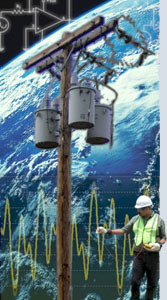Shocking at New Home Construction
Chester, South Carolina, USA
Background
A utility customer's home was under construction and the HVAC contractor was feeling a shocking sensation while installing the ductwork in the crawlspace of the house. They were experiencing the chocking voltage from 1:00 PM to 4:00 PM. The contractors stopped work each day at around 4:00 PM. Also, other utility customers in the same subdivision had the same experience within the previous several years.
Possible Causes
The initial investigation considered several possibilities:
- Faulty wiring on the customer side.
- Open or damaged underground primary cable neutral.
- Open or damaged system neutral.
Action Taken
The possible causes were ruled out by:
- Temporarily de-energizing the customer's wiring by pulling the power meter.
- Inspecting the underground primary neutral.
- Inspecting the system neutral because the are of new home construction is subject to tree-related damage.
The next step in the investigation was to measure the shocking voltage. The shocking voltage was measured at 2.45 VAC from the metal duct to the soil under the house.
The next step was to measure the neutral-to-earth voltage (NEV) along the underground line at the pad-mounted transformers. The NEV measurements were decreasing from the open point in the loop to the termination pole, except for 6.0 VAC at one transformer.
The next step was to take current readings at the pad-mounted transformers. The ground-rod current was 0.03 amps. The very low current reading indicated that the current was not exiting or entering the system. The decreasing NEV values indicated that the shocking voltage was related to the load.
The next step was to take current readings and NEV measurements on the circuit. The current readings for the total load in the subdivision was 30 amps. The current reading for the long single-phase line was 50 amps. One pole in the subdivision did not have a neutral bonded to the adjacent circuit. The neutral size for the subdivision load was #6 copper on this pole. The configuration of this pole was not standard because the neutral was rolled form a single-phase crossarm.
Solutions
The first part of the solution was to increase the system neutral size from #6 copper to 1/0 ACSR and to bond the neutral to the adjacent circuit on the unbonded pole. The increased neutral size and bonding would help to reduce the shocking voltage by reducing the neutral voltage drop.
The second part of the solution was to transfer the load to the adjacent circuit and balance the three-phase load or open-wye the long single-phase line to the subdivision.

